Petting a Million Dogs
Gideon Kidd, I've Pet That Dog
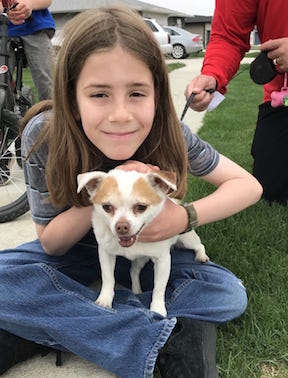 Gideon Kidd has a goal to pet a million dogs for his pet project. So far, the 9-year-old boy has pet more than 360 dogs in his Cedar Falls, Iowa hometown. He's chronicled his journey on Twitter, garnering over 90,000 followers. He'll tell us why he's doing this.
Gideon Kidd has a goal to pet a million dogs for his pet project. So far, the 9-year-old boy has pet more than 360 dogs in his Cedar Falls, Iowa hometown. He's chronicled his journey on Twitter, garnering over 90,000 followers. He'll tell us why he's doing this.
Gideon Kidd loves animals and has been petting every dog he comes across. He tells us he is doing this because he loves dogs and wants to show the public that dogs are these amazing creatures. At home, Gideon has one dog, three cats, two gerbils and one Venus flytrap.
Rachel, Gideon's mother, has created a twitter feed as well as a website for Gideon. Every time he pets a dog, she takes a picture and posts it on his website.
There is a method to Gideon's petting. He just doesn't walk up to any dog and start petting it. First, he asks caregiver if he can pet their dog. If they say yes, he goes up to the dog and puts his hand straight out under their nose and then they sniff it. If the dog growls or backs away, then dog does not want to be pet. But if the dog comes up to him and sniffs him, then he starts petting the dog.
Over the course of petting 361 dogs, Gideon tells us there have only been a couple that did not want to be pet. While he has been nipped at a couple of times, he has never been bitten.
So how does Gideon meet all of these people and their dogs? He tells us he drives around with his mother and then they park when they see a dog and he gets out. At first people think its kind of like weird and are like, "What is this kid doing?" But after he explains himself, they are willing to participate.
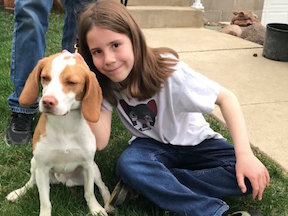 After petting so many dogs, it's hard to know which ones Gideon has already met before. So its no surprise that there have been dogs that Gideon has petted twice. Two that he can remember was a pug named Louie and another dog named Mo. Gideon explains that he didn't recognize Mo the second time, because he had been to the groomers and had a new haircut.
After petting so many dogs, it's hard to know which ones Gideon has already met before. So its no surprise that there have been dogs that Gideon has petted twice. Two that he can remember was a pug named Louie and another dog named Mo. Gideon explains that he didn't recognize Mo the second time, because he had been to the groomers and had a new haircut.
In order to complete his goal, Gideon's mother's friends will be bringing their dogs to him and he will be traveling to other places to meet more dogs. However, he will probably have to travel the country to meet a million dogs and maybe even do a tour!
Gideon tells us his dog Walter could care less about all of the dogs that he has been petting. In fact, he just pretty much sleeps all the time.
We will be checking back with Gideon in about 6 months to see how much closer he is getting to his goal.
Visit Website
Please Don't Repo Fido - Lawmakers Ban Pet Leasing
Bill Ketzer, ASPCA
 Puppies sold in pet stores, most of which are sourced from puppy mills, are often accompanied by soaring sticker prices. To make the puppies appear more affordable, private lending companies are offering leasing plans. Miss a payment and they can repossess your pup. Bill Ketzer, from ASPCA Government Relations, is asking lawmakers to end this predatory practice.
Puppies sold in pet stores, most of which are sourced from puppy mills, are often accompanied by soaring sticker prices. To make the puppies appear more affordable, private lending companies are offering leasing plans. Miss a payment and they can repossess your pup. Bill Ketzer, from ASPCA Government Relations, is asking lawmakers to end this predatory practice.
You know how it is, you walk into a pet store and see that cute little puppy in the window and you want it. However, it's so expensive and you know can't afford it. Then the salesman comes over to you and says that he can make this dog affordable for you. He will lease this pet to you for low monthly payments and doesn't really discuss the balloon payoff at the end.
Unfortunately, animals are treated as property in the eyes of the law, so if you lease a pet and you miss a payment, they could repossess that pet. For most of us that pet a family member, but for the leasing agency, it's just collateral.
Bill Ketzer is the Senior Director of ASPCA Government Relations for the Northeast Region and he tells us that while is a very disturbing trend, currently there's great legislation being made across the country to change it. He explains he first became aware of it a couple of years ago when he initially worked with the State Department of Agriculture and markets to try to figure out through the random animal inspectors who regulate many of these entities, just how prevalent it was. At that time, it didn't seem like it was going to be something that was going to catch on. But boy, it certainly has. He tells us that in working with that agency, he's starting to figure out just how prevalent the practice is. In fact, there's one local chain that states on the record that over 30-percent of their annual sales are from leasing agreements.
Leasing pets capitalizes on the emotional connection people feel towards a puppy to kind of lure them in and say I can make this affordable for you for only $50. You can walk out this door today with only $50 down and low monthly payments of $50 a month. Unfortunately a lot of people don't even know they're entering a lease agreement. They think it's traditional financing. They think when they walk out of that store that they own that animal free and clear.
Besides taking advantage of emotional consumers that see that cute puppy in the window, having a third party retaining ownership has to raise some ethical questions about who's really responsible and even permitted to make important medical decisions on behalf of the animal.
Bill tells us he has reviewed some of these contracts and there's no one set way to structure them. However, at the end of the day, if you don't own the animal, then there is a definite ethical concern as to whether you are actually liable to provide medical care. But of course you're going to provide the medical care because this is now your family member. You're not going to walk away from an animal that needs medical care. However, at the end of the day if you miss a payment, they could come and get that animal whenever they want. And the back end question is, "Where's that animal going to go?"
What if a dog needs life saving surgery that's too expensive for the owner to afford and they can't pay for it, what happens to the dog? Who's responsible to save its life? What if it gets repossessed, what happens to it then?
 This all depends on the small print in the contract. These companies don't want to repossess an animal. What they would rather do is have either the lender itself or a vendor that they hire for collections work with the purchaser who has the lease and restructure the agreement. They may lower your monthly payment, but then extend the terms. Basically they're going to try to get you into another contract to make it amenable for both sides in theory. Unfortunately any new agreement is still not amenable to the pet owner. Remember, they're in the business of making money, not in the business of taking care of animals.
This all depends on the small print in the contract. These companies don't want to repossess an animal. What they would rather do is have either the lender itself or a vendor that they hire for collections work with the purchaser who has the lease and restructure the agreement. They may lower your monthly payment, but then extend the terms. Basically they're going to try to get you into another contract to make it amenable for both sides in theory. Unfortunately any new agreement is still not amenable to the pet owner. Remember, they're in the business of making money, not in the business of taking care of animals.
One such company that does this type of leasing is called WAGS. So far they've serviced 66,000 pet leases and state that they have never repossessed a pet ever, which makes you wonder what kind of power these loans really have. These companies don't want to repossess an animal, but what they will try to do is work through a collection agency to encourage the purchaser to restructure the deal so that it's more affordable for them in the short term of monthly payments. But at the end of the day, the purchaser is still going to be paying two to three times the amount that they originally signed up for at retail. These animals go for at retail for anywhere from $1,000 to $3,500, maybe even more, depending upon the breed. And if you're paying three times that amount at the end of term, plus a balloon payment at the end to actually own the animal, that's a lot of money.
This is a predatory practice according to Bill. And it's not just about leasing, it's also about the nature of the industry in general. This is a moneymaking industry. This owned "property" is a living and sentient entity that is not a chair. It's not a television. It shouldn't have to be repossessed. It's also not something that you just forget about it after like a couple of years and put it to the curb. This is a long time commitment for people who care deeply about their animals.
So the extent is that there wouldn't be this pressure to sell these animals for all this money if you didn't have this wholesale high volume-breeding environment that is kind of coughing all of these animals into these retail systems.
The system is broken. It's not readily regulated in a meaningful way by the federal government. As a matter of fact, the federal government is making it very difficult for the public to get information from them regarding the source of these animals.
Obviously, it's best to adopt from shelters and rescue organizations and not purchase an animal retail. But if you did and wanted to find out the source of the animal or the history of the breeder that sent the animal to the pet store, it's very difficult to do. Knowledge is key and knowledge is power. Bill encourages anybody who has a voice to put information out there to the public and inform them about the nature of the industry at large and certainly about these unfortunate predatory practices that retailers are using to help this horrific industry.
On the flip side, many cities are now learning towards the sales of pets in stores to come from shelter or rescue organizations. This is essentially a retail environment that provides space for nonprofit shelters or rescue organizations for adoptions. However, Bill cautions that we don't want to ultimately turn shelters and rescues into retailers. There's a lot of nuance there Bill doesn't get into, but under the right circumstances, he thinks there would be a comfort level with that, but it has to be done very, very carefully.
Visit Website
Managing Leash Aggression
Dr. Wailani Sung, Fear Free
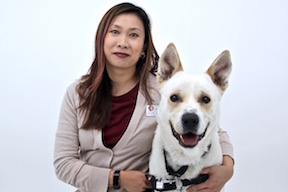 Board Certified Veterinary Behaviorist Dr. Wailani Sung studies and treats 'leash aggression.' She'll help you control your lunging dog. This feature is part of the Fear Free Pets Expert Series, helping your pet live a happier and healthier life.
Board Certified Veterinary Behaviorist Dr. Wailani Sung studies and treats 'leash aggression.' She'll help you control your lunging dog. This feature is part of the Fear Free Pets Expert Series, helping your pet live a happier and healthier life.
Dr. Wailani Sung is one of 74 Board certified veterinary behaviorists in the United States and is currently the only veterinarian certified in clinical veterinary behavior in the state of Washington.
According to Dr. Sung, leash aggression specifically refers to a dog being really reactive when the leash is on them. When she says reactive, she's talking about barking and lunging and potentially even escalating to more aggression towards other dogs or other people.
Since this reaction is classified as leash aggression, we know one of the triggers is being leashed, which only occurs when the dog is on leash. When the leash is off, this behavior should not occur.
Leash aggression can happen in all breeds of dogs. Dr. Sung has seen leash aggression in every type of dog from a 5-pound Chihuahua up to a 150-pound St Bernard. Any breed can have leash aggression; it just depends on the underlying motivator for that dog to be reactive.
There are some things you can do to manage leash aggression depending on the size of your dog. When a dog is 20 to 30 pounds or under, it's much easier to restrain them on leash. However, if your dog is much bigger, you might want to think about using a head collar, which gives you control over their head. This makes it really hard for them to pull and pull you down, which happens frequently to people walking their dogs and can end up in injury to the person. So with a head collar, they can't get the momentum to pull you forward. When they lunge forward, the pressure of the head collar pulls their head to the side. It's the same concept we use on large animals, such as horses and cattle. So if you have a really big dog, maybe 50 pounds and over, you should consider using a head collar, a harness and a double ended leash. You can then attach one end to the head collar and the other end to the harness. This will allow you to have two points on them, which gives you 50-percent control over their upper part of their body.
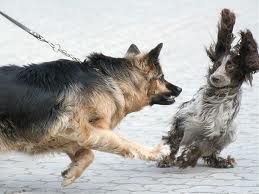 If you have a dog with a leash aggression, you might want to avoid other dogs while walking. However, if you feel like your dog can be friendly and can meet other dogs, then you should be in an environment where you can take the leash off or have enough slack in the leash. Sometimes if the dog has a leash on but there's enough slack in the leash and they're not feeling the pressure from the collar, they are much calmer and they can successfully meet other dogs. Just be sure to choose an area where they can have a lot of slack on the leash. If you do choose to remove the leash, make sure it's in a safe area where you can do this. However, you should only take the leash off if you have good verbal control over your dog and are able to recall your dog back to you.
If you have a dog with a leash aggression, you might want to avoid other dogs while walking. However, if you feel like your dog can be friendly and can meet other dogs, then you should be in an environment where you can take the leash off or have enough slack in the leash. Sometimes if the dog has a leash on but there's enough slack in the leash and they're not feeling the pressure from the collar, they are much calmer and they can successfully meet other dogs. Just be sure to choose an area where they can have a lot of slack on the leash. If you do choose to remove the leash, make sure it's in a safe area where you can do this. However, you should only take the leash off if you have good verbal control over your dog and are able to recall your dog back to you.
Even if your dog doesn't have leash aggression, you should be careful when meeting up with strange dogs. Dr. Sung suggests to slow down when you get within two or three feet of another dog. She says it is a good practice to call out to the dog's owner and ask, "Hey, is your dog friendly," to make sure that their dog is comfortable. Even if they say yes, you should always evaluate the other dog's body language. Look at the other dog and see if it looks nervous or if it's eager to meet your dog. Is their head forward and is their tail medium height or elevated? If you do agree to let them meet, let them start out by sniffing each other, maybe two seconds maximum, and then call them off. If they are not naturally moving on their own, call your dog and take a step back and give both dogs a break. Make sure they can check each other out at a distance. If they seem like they want to sniff again, go ahead and approach the other dog and let them sniff a second time.
If you are dealing with leash aggression, there are many solutions available. You can try to work with your dog on doing a massive amount of counterconditioning by using a lot of treats or by using something else your dog is really willing to work for. Then every time they see another dog and you can get their attention focused on you, you can reward your dog for not being reactive.
If you do need more help beyond that, you can certainly engage the services of a certified trainer that has experience dealing with this problem.
There are also certified applied animal behaviorists. These are people that have advanced degrees in animal behavior. They either have a Master or a PhD in animal behavior. Or, you can contact a board certified veterinary behaviorist. These are veterinarians that have advanced training and have been through residency and completed certification that enables them to help you and your dog with your specific problem.
You want to deal with this problem in a positive manner. Visit the Diplomate of the American College of Veterinary Behaviorists (DACVB) to find a board certified veterinary behaviorist.
Visit Fear Free Happy Homes for tips on making your home fear free and to locate a Fear Free Veterinarian near you. Go to Fear Free Pets to become certified.
Listen and Explore the Fear Free Expert Series
The Dangers of Doggie Dragon Breath - Dr. Debbie
 Does your dog's breath cause you to gag and turn away? Are your pet's kisses unwelcome due to fetid breath? Many dog owners recognize that distinctive smell which is often accepted as a condition of dog ownership. But stinky dog breath, while common, is actually a symptom of illness and should not be ignored. Doggie dragon breath, just like a blinking traffic light, is a sign of danger ahead. Don't ignore dog breath for what it is - an indicator of oral infection that if left unchecked will impact your dog's health and shorten his lifespan.
Does your dog's breath cause you to gag and turn away? Are your pet's kisses unwelcome due to fetid breath? Many dog owners recognize that distinctive smell which is often accepted as a condition of dog ownership. But stinky dog breath, while common, is actually a symptom of illness and should not be ignored. Doggie dragon breath, just like a blinking traffic light, is a sign of danger ahead. Don't ignore dog breath for what it is - an indicator of oral infection that if left unchecked will impact your dog's health and shorten his lifespan.
What's the big deal about bad breath? It's more than just the smell. Bad breath, also referred to as halitosis, arises from plaque and oral bacteria. Periodontal disease progresses as plaque accumulates, mineralizes into tartar, and inflammation causes destruction of the supportive tissues around the teeth. Dogs don't simply get cavities, rather they will lose their teeth as connective attachments deteriorate. Untreated dental infections jeopardize the health of nearby teeth and may lead to osteomyelitis - infection in the bone. And with time, untreated periodontal disease showers the bloodstream with bacterial products leading to other diseases such as liver, kidney and heart disease.
Fight Halitosis
The best way to control periodontal disease is to assume an offensive attack. Monitor your pet's oral health by flipping up your dog's lip to discover what is lurking underneath. Look for red inflamed gums, yellow or brown accumulation on the teeth, tooth discoloration, or bad breath. Any symptoms of periodontal disease should be addressed with your veterinarian. Have your pet's teeth cleaned regularly at the veterinary office and follow up with home dental care including daily brushing.
These professional veterinary cleanings are important to safely remove mineralized tartar, clean under the gum line, permit a thorough oral exam and take x-rays. Veterinary dental x-rays are an essential tool in detecting problems and have been shown to identify oral disease in 28-percent of dogs and 42-percent of cats that have an outwardly normal mouth.
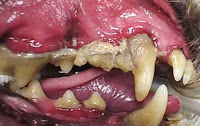 Don't fall into the hype about herbal spray-on products or 'awake' dental procedures - these only offer a cosmetic improvement in visible tartar, which only covers a small part of the tooth. These methods, often incorrectly touted as a safe alternative to professional cleanings, can't address the 60-percent of a dog's tooth which lies under the gum line - exactly where periodontal disease brews and does its damage.
Don't fall into the hype about herbal spray-on products or 'awake' dental procedures - these only offer a cosmetic improvement in visible tartar, which only covers a small part of the tooth. These methods, often incorrectly touted as a safe alternative to professional cleanings, can't address the 60-percent of a dog's tooth which lies under the gum line - exactly where periodontal disease brews and does its damage.
Once you identify that nasty doggie breath, you can be certain some degree of periodontal disease is present and dental intervention is needed. Statistics show that by 3 years of age 80-percent of dogs and cats already have periodontal disease. Don't forget that small and toy breeds of dog have accelerated dental problems diagnosed as young as 1 to 2 years of age.
Think prevention - have your dog's teeth cleaned and embrace home dental care steps. And the next time you find yourself in a cloud of canine halitosis, you won't turn the other way - you'll grab that toothbrush.
Featured veterinarian known as "Dr. Debbie" on national pet radio program, Animal Radio. Ebook author of "Yorkshire Terriers: How to Be Your Dog's Best Friend"; "Pugs: How to Be Your Dog's Best Friend"; "Mini Schnauzers: How to Be Your Dog's Best Friend"; and "Shih Tzu: How to Be Your Dog's Best Friend." Dr. Debbie's books.
Visit Website
Animal Radio News - Lori Brooks
 More Tigers Kept As Pets Than Living In The Wild
More Tigers Kept As Pets Than Living In The Wild
There may be more captive tigers in the US than wild ones in the rest of the world. However, in states like Texas, no one really knows how many tigers are being kept as pets. As many as 7,000 tigers live in the US, either in zoos or as exotic pets, which is nearly double the estimated 3,900 tigers still living in the wild around the world. So, does that mean these pet tigers are a part of the endangered tigers roaming the wild? No. That's because the Endangered Species Act does not cover exotic pets, as it only applies to animals taken from the wild. Many pet tigers come from US breeders and because they are considered pets, it is actually up to the state to deal with it. This report came from the BBC which noted the majority of tigers in the US come from breeders to supply the cub petting industry that are used in petting zoos for parties and events.
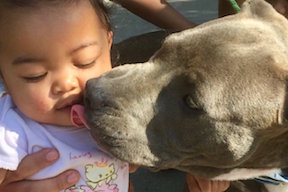 Pit Bull Puppy Saves Baby
Pit Bull Puppy Saves Baby
A pit bull puppy in Northern California is being called a hero. Sasha the puppy is only 8 months old and she and her baby human sister were born only a few days apart. Now, that bond is even stronger after Sasha alerted the family to a fire at the neighbor's house that was spreading to their home. The house was part of a duplex and the fire had started next door and was quickly spreading. The family was sleeping and Sasha was outside. She started barking and banging on the door. When the door opened, Sasha ran to the bedroom and got the baby off a bed by her diaper before the mother had even arrived in the room. Normally Sasha is kept inside, but her family is glad she was outside on this one occasion, as she was able to detect the fire quickly.
Smart Toilet For Cats
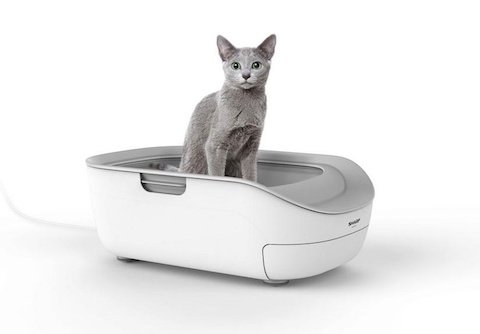 Sharp, the electronics maker has a hot new pet product set to go on the market next month, but as of right now, it'll only be in Japan. It's a smart toilet for cats that can automatically measure urine data and the weight of the cat to keep track of its health. It will also alert its human if any abnormality is detected. The Sharp Pet Care Monitor will go on sale July 30 for $226. Here's how it works: It measures the cats' weight, urine volume and frequency and length of time spent on the toilet. Next, all the data is analyzed. If there is any abnormality, like a cat spending an unusually long time on the toilet or the amount of urine being abnormally large or small, the owner is then alerted through a cell phone app. What if you have multiple cats? In that case, a sensor for identifying each cat is available and can be used in combination with the smart toilet to keep tabs on the health of up to three cats. It is now estimated there are 9.5 million cats in Japan outnumbering pet dogs (at 8.9 million) for the first time.
Sharp, the electronics maker has a hot new pet product set to go on the market next month, but as of right now, it'll only be in Japan. It's a smart toilet for cats that can automatically measure urine data and the weight of the cat to keep track of its health. It will also alert its human if any abnormality is detected. The Sharp Pet Care Monitor will go on sale July 30 for $226. Here's how it works: It measures the cats' weight, urine volume and frequency and length of time spent on the toilet. Next, all the data is analyzed. If there is any abnormality, like a cat spending an unusually long time on the toilet or the amount of urine being abnormally large or small, the owner is then alerted through a cell phone app. What if you have multiple cats? In that case, a sensor for identifying each cat is available and can be used in combination with the smart toilet to keep tabs on the health of up to three cats. It is now estimated there are 9.5 million cats in Japan outnumbering pet dogs (at 8.9 million) for the first time.
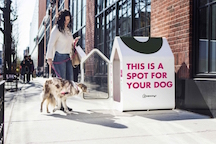 Sidewalk Sanctuaries For Dogs
Sidewalk Sanctuaries For Dogs
DogSpot, formerly known as Dog Parker, will expand to more than a dozen cities this year. The idea for DogSpot started in Brooklyn, New York. DogSpot makes sidewalk sanctuaries for dog that would otherwise be stranded at the entrance of businesses where dogs are not allowed. The technology-enabled dog houses serve as a safe, legal and convenient alternative to tethering or leaving dogs in cars or out on the sidewalk. In DogSpot doghouses, there's heat and A/C, auto-sanitizing UV lights, an in-app Puppy Cam and 24/7 customer service, according to company officials. Among the cities that will add DogSpot sanctuaries within the year are Los Angeles, CA; Washington, D.C.; Boston, MA; San Jose, CA; Orlando, FL; Columbus, OH; Jersey City, NJ; and Charleston, SC. The expansion follows a pilot in Brooklyn, NY, that boasted a 50-location network built on partnerships with local businesses that were committed to becoming more dog friendly. Data showed that consumer behavior changed radically, specifically that users switched where they shopped in favor of stores with a DogSpot and felt less rushed while they were shopping than when they had tied their dog up outside
 Ed Sheehan's Wax Model Ends Up in Cat Cafe
Ed Sheehan's Wax Model Ends Up in Cat Cafe
Pop music star Ed Sheeran is such a cat lover that earlier this month Madame Tussauds Wax Museum in London unveiled a wax model of the British musician at Lady Dinah's Cat Emporium - it's a cat café in London. The statue was moved to the museum last week after was Ed had a week to hang out with the cool cats at the cafe.
Pets Owners Are Becoming Tech Savvy
It might soon be difficult to have a pet if you're not tech savvy, according to a new report from the Consumer Technology Association. They asked pet parents what tech devices they are most likely to buy within the next year. The most popular answers were interactive toys, automated feeders, grooming devices and pet GPS trackers. It's estimated these devices will increase 20-percent in sales this year. Safety and peace of mind are the biggest drivers of future pet tech purchases, as seen by the interest in automated feeders, vet and pet safety apps, pet GPS' and more. But, it's not all about dogs. Of those who own pet tech devices, 45-percent of cat owners use tech devices at least once a day, compared to 35-percent of those who have dogs. However, both cat and dog owners are willing to use tech to address their furry child's issues. Thirty-five percent of dog owners say training is the biggest issue pet tech should solve and for those who have cats, they say monitoring their pet's nutrition is their biggest priority.
 Listen to the entire Podcast of this show (#969)
Listen to the entire Podcast of this show (#969)





